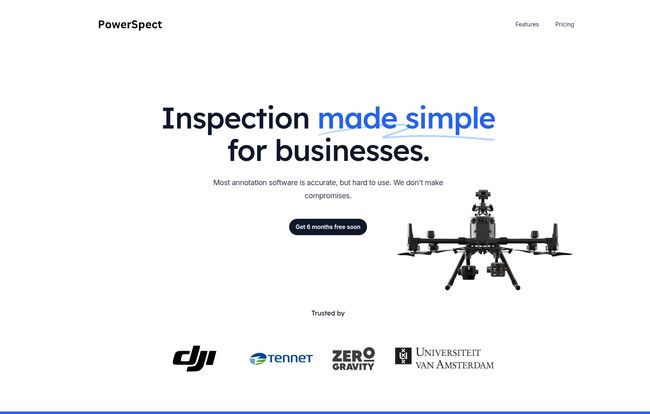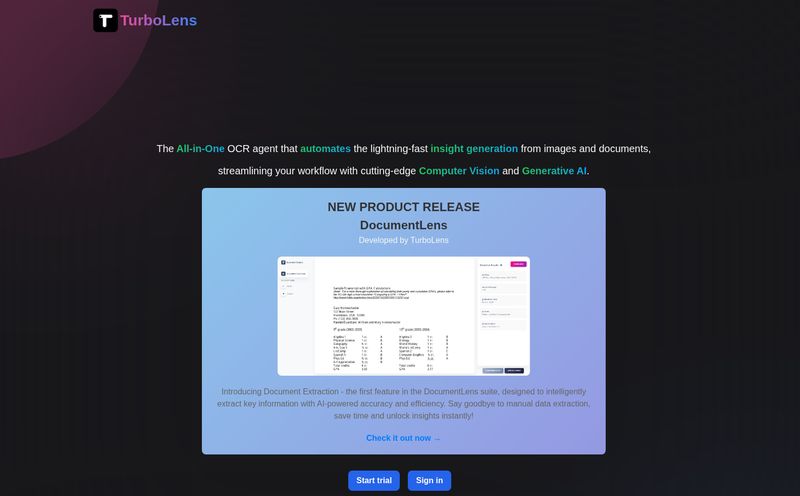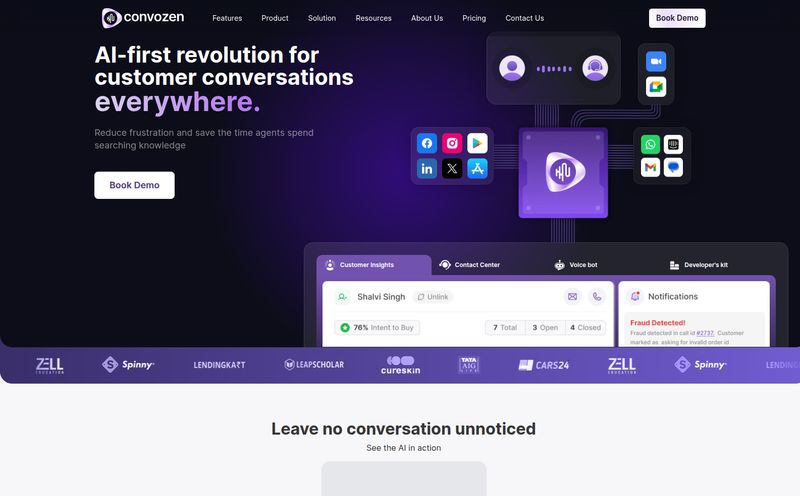For years, the world of industrial inspection has been… well, a bit stuck in the past. We're talking about brave folks climbing dizzying heights, poring over schematics, and relying on binoculars and a whole lot of gut feeling. It’s slow, it’s expensive, and frankly, it can be pretty darn dangerous.
I’ve been in the SEO and traffic game for years, and I’ve seen countless tech companies promise to change the world. Most of them are just selling shiny new versions of old ideas. But every now and then, something comes along that makes you sit up and pay attention. Something that feels like a genuine shift. Today, I want to talk about one of those platforms: PowerSpect.
They claim to make inspection simple for businesses using AI. A bold claim. So, I did what I do best—I dug in to see if it’s just marketing fluff or the real deal. Is this the future of keeping our power grids and infrastructure running?
So, What Exactly is PowerSpect Anyway?
Forget the jargon for a second. At its heart, PowerSpect is a brain for your physical assets. Imagine you're in charge of a massive network of transmission towers. Hundreds of them. Thousands. You can't be everywhere at once. PowerSpect aims to be your eyes in the sky, your nerve endings on the steel, your 24/7 watchman that never sleeps or takes a coffee break.
It’s an AI-powered platform that takes in data—mostly high-res images from drones (their partnership with DJI is a big hint) and data from IoT sensors—and analyzes it. It’s not just about spotting a bit of rust. It's about building a living, breathing digital twin of your infrastructure and using it to forecast problems before they become catastrophes. Think of it less as a simple inspection tool and more as an operational intelligence engine.
It's a big step away from the old clipboard-and-camera routine, that's for sure.
A Look at the Core Features
Okay, so it sounds cool. But what does it actually do? The platform is built around four main pillars. Let’s break them down without the corporate-speak.
Automated Inspection with an AI Brain
This is the headline act. Instead of sending a crew out to visually inspect every inch of a tower, you send up a drone. It captures thousands of images, which are then fed into PowerSpect's AI models. The system is trained to spot defects—corrosion, damaged insulators, loose bolts, you name it. It automates the tedious, time-consuming part of the job, freeing up human experts to focus on the really complex issues. This isn't about replacing engineers; it's about giving them superpowers.
Predictive Maintenance is the Real Money-Saver
Here’s where things get interesting for the CFOs out there. Reactive maintenance is a budget-killer. Something breaks, and you scramble to fix it, often paying a premium for emergency work and losing revenue from downtime. PowerSpect flips the script. By analyzing historical data and current trends, it tries to predict failures. It might flag a component that’s degrading faster than usual and say, “Hey, you should probably replace this part in the next three months before it fails during a storm.” That’s a game-changer. It moves maintenance from a cost center to a strategic investment.
Always-On with Real-Time Monitoring
While drone inspections are great for periodic check-ups, what about the day-to-day? This is where IoT sensors come in. By integrating with sensors on your equipment, PowerSpect can keep a constant pulse on the health of your grid. It provides instant alerts for anomalies, like a sudden temperature spike or unusual vibrations. It's the difference between seeing your doctor once a year and wearing a fitness tracker that monitors your health continuously.
Reporting That Actually Makes Sense
Data is useless if you can’t understand it. I’ve seen so many platforms that just dump endless spreadsheets on you. It's overwhelming. PowerSpect seems to get this. Their focus is on generating detailed, actionable reports. This means managers get clear overviews of system health, and engineers get the specific data they need to plan maintenance tasks. The goal is to turn a mountain of data points into a clear, concise to-do list.

Visit PowerSpect
The Million-Dollar Question: What's the Price?
Alright, let's get down to brass tacks. A platform this powerful isn't going to be free. The pricing structure is pretty straightforward, which I appreciate. No hidden fees or confusing credit systems, it seems. They've got three tiers aimed at different scales of operation.
| Plan | Price | Best For | Key Features |
|---|---|---|---|
| Starter | $500 | Self-employed / Consultants | Annotation software, 10 scenes/day, Pay as you go |
| Small Business | $1,500 | Small to Medium Businesses | Access to all features, 150 scenes/day, Pay per model |
| Enterprise | Contact Sales | Large Corporations | Unlimited models, Custom SLA, Dedicated support, Custom branding |
My take? The prices might seem steep to an outsider, but for their target market—utility companies, large-scale infrastructure managers—it's a drop in the bucket. A single unexpected tower failure could cost hundreds of thousands, if not millions, in repairs and lost service. From that perspective, $1500 a month for the ability to prevent that is a pretty good deal. The Starter plan is a nice touch, allowing smaller consultants or companies to test the platform without a massive commitment.
The Good, The Quirks, and The 'Coming Soon'
No tool is perfect. In my experience, it's important to look at both sides. The biggest advantage of PowerSpect is obvious: it brings a massive efficiency and safety boost to an old-school industry. Automating routine work and preventing catastrophic failures is a powerful one-two punch.
On the other hand, you’re placing a lot of trust in the AI. The system is only as good as the data it's trained on. If the AI models aren’t accurate, you could either miss critical issues or get swamped with false positives. It's a classic "Garbage In, Garbage Out" situation. I'd want to see some serious case studies and accuracy stats before going all-in.
And then there’s the little teaser on their site:
We're putting the finishing touches on our cutting-edge 3D inspection software.
This is intriguing but also a bit of a question mark. What does it do? How is it different? It feels like they're holding one of their best cards close to their chest, which is great for building hype but a little frustrating for a potential customer trying to evaluate the whole package right now.
My Final Take: Is It a Revolution in a Box?
So, what's the bottom line? I think PowerSpect is more than just a neat peice of software. It represents a fundamental shift in how we manage and maintain the physical world around us. For too long, the digital revolution was about websites and apps. Now, we're seeing it transform concrete and steel.
It’s not for everyone. If you're not managing a significant amount of physical infrastructure, this is overkill. But for the intended audience—the TenneT's of the world—this could be incredibly valuable. It’s a tool that promises not just to save money, but to build a more resilient, reliable, and safer infrastructure for everyone. And in a world that depends so heavily on a stable power grid, that’s a pretty compelling proposition.
Frequently Asked Questions
- 1. What kind of businesses is PowerSpect designed for?
- Primarily, it's built for companies that manage large-scale, critical infrastructure. Think electric utility companies, energy providers, and large industrial operations with extensive physical assets like transmission towers.
- 2. Do I need to own drones to use the platform?
- The platform is designed to analyze data, particularly images. While they partner with DJI, you'd likely either use your own drone fleet or hire a service provider for data capture. PowerSpect is the software brain that processes that data.
- 3. Is the pricing a monthly subscription?
- Yes, the pricing for the Starter and Small Business plans appears to be a recurring fee. The Starter plan is a pay-as-you-go model, giving flexibility, while the Enterprise plan is a custom arrangement.
- 4. How accurate is the AI in detecting defects?
- This is the critical question. The accuracy depends on the quality of their AI models and the data they're trained on. While they claim to create superior models with high-quality data, potential customers should definitely ask for performance metrics and case studies.
- 5. Can PowerSpect be used for inspecting other assets besides transmission towers?
- While the main example is transmission towers, the underlying technology—analyzing images and sensor data for defects and predictive maintenance—could theoretically be applied to other assets like wind turbines, bridges, pipelines, or buildings. You'd want to confirm this with their sales team for your specific use case.
- 6. What is the 'annotation software' included in the Starter plan?
- Annotation software is used to label images to train AI models. For instance, you would use it to draw boxes around rust spots or broken parts in thousands of images, teaching the AI what to look for. Including this suggests users can have a hand in training or refining models for their specific needs.
Conclusion
PowerSpect is stepping into a space that’s ripe for innovation. By combining AI, drone imagery, and IoT data, they’re offering a compelling solution to the age-old problem of infrastructure maintenance. It's an ambitious platform with a price tag to match, but for the right company, the return on investment in terms of safety, efficiency, and failure prevention could be immense. It will be fascinating to watch them grow, especially when they finally reveal that new 3D inspection software.



